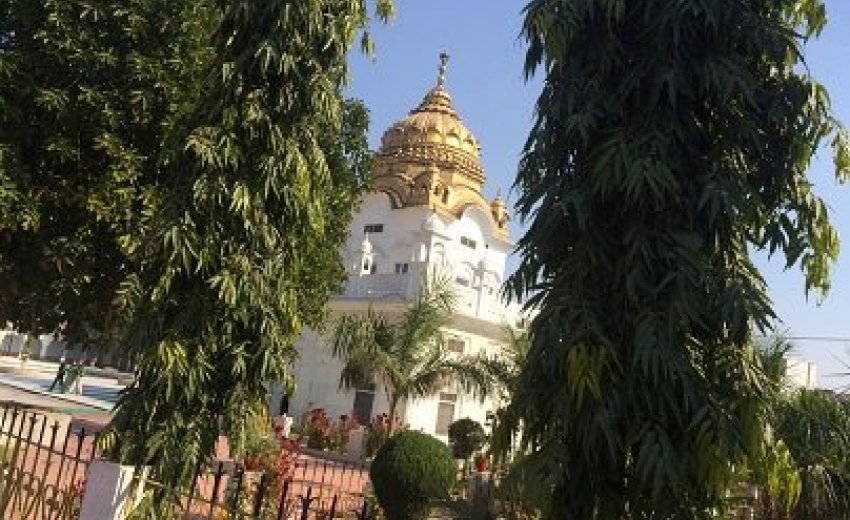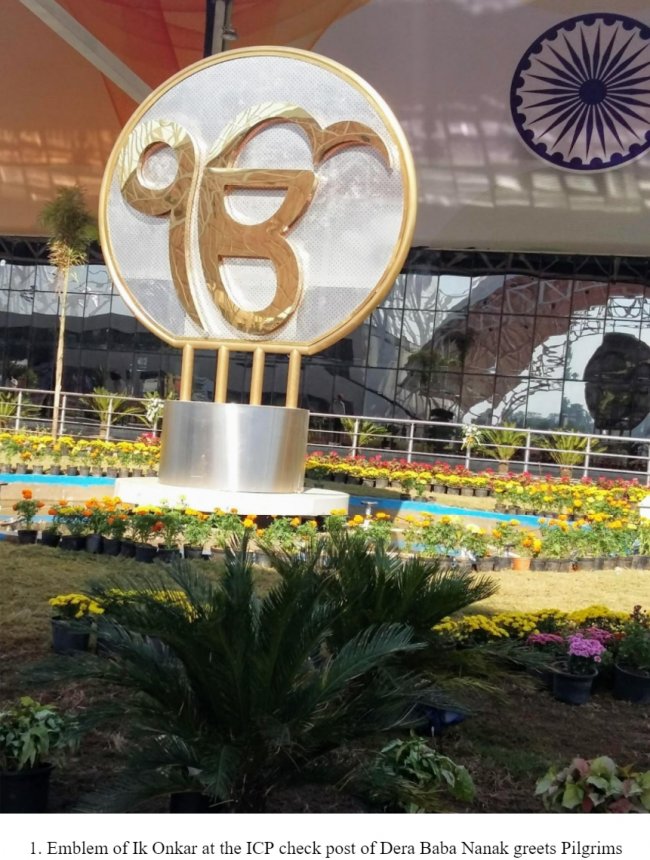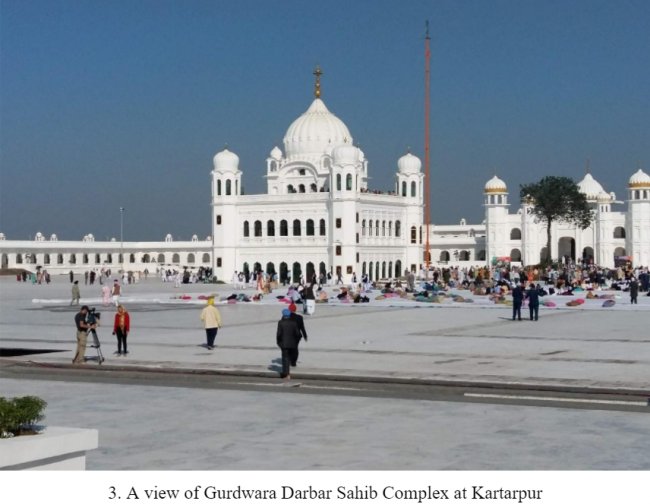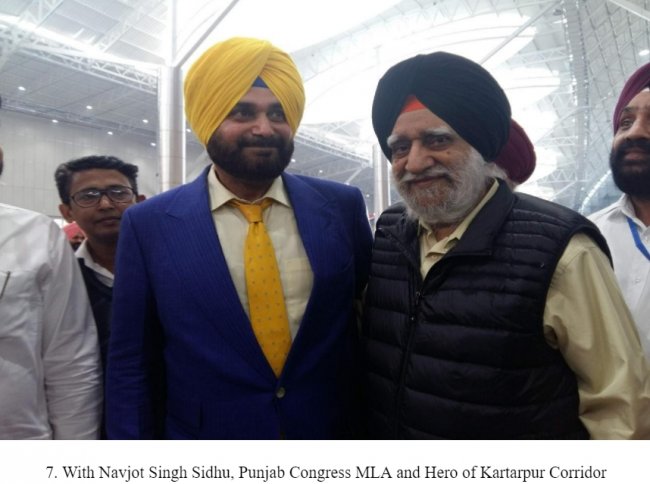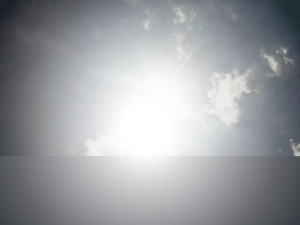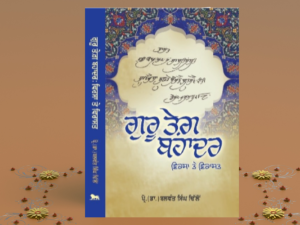I have a vague memory of my visit to Nankana Sahib as a child of five years with my mother. She took me sometimes from Kamoke to Rori Sahib in Eminabad but my memory of these visits has faded. Long after partition, when I was teaching at Guru Nanak Dev University, Amritsar, I was invited to participate in a Physics Workshop organised by ICTP, Trieste, Italy under the Directorship of Nobel Laureate Abdus Salam at Nathia Gali, a hill resort near Abbotabad, for four weeks in June 1981. After the Workshop, I visited my birthplace at Kamoke in Gujranwala district, and Nankana Sahib before my return to India. It was a sentimental journey connecting to my roots and my faith. In Lahore, my visit was hosted by two friends, Jean Marie Lafont, a French historian of French Generals in the Khalsa Raj army of Maharaja Ranjit Singh, and Engineer Dr. Asgar Ali who was my contemporary in the International Hall of Paris University in 1971. I got the opportunity to visit my birthplace and Nankana Sahib in 1984 and 1988 also.
During my years of service at Guru Nanak Dev University, Amritsar (1979-2002), I made a family trip to Dera Baba Nanak in 1982. Those days, there was no facility to watch gurdwara Darbar Sahib at Kartarpur across the river Ravi through the telescope set up on a mound that has now been set up. It was not in my dreams that one day I will be part of the first Jatha to cross the border through the Kartarpur Corridor at Dera Baba Nanak. It is not less than a miracle that the prayers of thousands of Sikhs have been fulfilled during my lifetime.
It was sometime during mid-October when I received a phone call from Sirdar Tarlochan Singh (Ex-MP Rajya Sabha) and my senior in Mohindra College Patiala, informing me about my nomination for the inclusion in the first Jatha visiting Kartarpur Sahib on 9th November, 2019, the day of opening of the Corridor by Prime Ministers of both India and Pakistan. Nothing happened for two weeks as there were many hurdles to cross. Suddenly, I received a phone call from the office of Hardip Singh Puri, the Minister Incharge responsible for giving clearance to members of the first Jatha. Within a week, an online application was filled up, police verification was done, and electronic clearance was received by me. I was asked to reach Dera Baba Nanak by 8th November evening.
As advised by the Ministry, I took my Passport and some other documents and boarded the evening bus for Gurdaspur. Just when the bus moved out of the bus stand, I got a call from Delhi that I should carry 20 US Dollars to pay as entry fee at the immigration check post before entering Kartarpur Sahib. There was no time to collect this fee in foreign exchange as the Banks were already closed. I thought of moving ahead thinking that if not allowed to enter Pakistan, I can return from Dera Baba Nanak. I rang up my host, Swaran Singh Virk, Principal of Riarki College, Tugalwal to arrange 20 US dollars from somewhere. I got a reply from his son, Gagan Virk, that he will definitely arrange it for me. It was pitch dark when I landed in Tugalwala village. To my surprise, I found that Gagan had arranged 20 Canadian dollars instead of US dollars!
Next morning, I started my journey to Dera Baba Nanak unsure of my entry through the Kartarpur Corridor. On the way, I got a call from the DSP of Batala Police district to get a sticker for the entry of my vehicle at Kalanaur check post. Due to the visit of Prime Minister, Narendra Modi, all routes to Dera Baba Nanak were under control of the police and para-military forces. We passed many roadblocks before reaching the final destination. I was issued a sticker and allowed to proceed to the Indian check post. On both sides of the road, I saw a tent city erected for the convenience of pilgrims. Due to heavy rain during the previous night, all the arrangements went haywire. At 10 AM sharp, I reached the integrated check post (ICP) built by the Land Port Authority of India at Dera Baba Nanak.
The entry gate to ICP greets you with a beautiful golden symbol of Ik Onkar erected on a high pedestal. After bowing my head to the insignia used by Guru Nanak to represent God and His creation, I was ushered into the reception hall by the security people. There was a great hustle and bustle of political leaders of all hues and their cronies. I started looking for my acquaintances and occupied a seat among Punjabi university academics, including Prof. Balkar Singh and the Vice Chancellor, Prof. BS Ghumman. I spotted my friend and benefactor, Tarlochan Singh, in the crowd and thanked him for proposing my name.
There was a mood of elation in the reception hall. I found MLAs of Punjab Congress dominating the proceedings but there was an atmosphere of bonhomie and goodwill never seen before among the politicians of Punjab. Aam Admi Party MLAs were present in full strength but those of BJP and Akali Party were keeping low profile. I was told that most of the Akali leaders were attending a prayer meeting organised by SGPC at Chhikar Machhian, 10 km away from Dera Baba Nanak, where PM Narendra Modi, CM Amarinder Singh and Ex-CM Parkash Singh Badal were also present. This thanksgiving ceremony lasted well past noon and we were kept waiting for the opening ceremony of the Kartarpur Corridor till 2.30PM.
To kill time, I started mingling with political leaders. I knew Prem Singh Chandumajra and few others from my days of service in Punjabi university, Patiala. I exchanged pleasantries and captured Mohd. Sadiq, Bhagwant Mann, HS Phoolka and Navjot Singh Sidhu in my camera. Navjot Singh Sidhu was an acknowledged "Hero" of the Kartarpur Corridor. Almost everyone in the reception hall and the Press gallery was jostling to get hold of Sidhu for his comments but he kept mum, while posing for selfies. My niece, Ginny Virk, rang me to report that my photo with Sidhu has been published by Jag Bani on their facebook page. Political leaders avoided interaction with Sidhu being afraid of ridicule by their masters.
At 2.30 PM, there was a sudden announcement that PM Narendra Modi had arrived to open the Corridor. He was accompanied by CM of Punjab, Hardip Singh Puri, Sukhbir Badal, Harsimrat Badal, Gobind Singh Longowal, President of SGPC, and Giani Harpreet Singh, Jathedar Akal Takhat. After offering Ardas by Jathedar, PM Modi performed the ceremony of raising the cover from the plaque declaring the Kartarpur Corridor open. I could watch from a distance that PM Modi was supporting a Kesari turban for this occasion. I had completed the check-in formality at the Indian immigration counter in the morning. Since we were getting impatient to cross over the border, there was almost a gate crashing after PM Modi left the scene. I could never imagine the indiscipline shown by the top leaders of India. But then I could recollect their halla-gulla inside the Punjab Assembly and the Indian Parliament. The attitude and behaviour of our Border Security Force (BSF) on the Indian side was not praise worthy at all. They kept us on tenterhooks till the last moment.
At 3 PM, we crossed the "No Man" land and entered Pakistan. We were treated with broad smiles on the other side. Pakistani buses took us to the Check Post and within a few minutes the formalities were completed. Our Passports were not stamped, instead we were issued entry permits to be deposited on return from Kartarpur Sahib. As was declared by Pakistan PM, Imran Khan, no entry fee was collected from members of the first Jatha. Outside Checkpost, a fleet of new buses was waiting to transport us to the final destination of Gurdwara Darbar Sahib at Kartarpur. The ladies among our group started reciting "Satnam Vaheguru" in a melodious voice and we were transported to the celestial realms of Gurbani.
On the way to Darbar Sahib, we crossed the river Ravi meandering its way between India and Pakistan borders. It was Ravi deluge, a few years after Guru Nanak left his mortal frame, which destroyed the Kartarpur Sahib dharamsal and both the sons of Guru Sahib moved to the present site of Dera Baba Nanak. Maharaja Bhupinder Singh of erstwhile Patiala State rebuilt the present structure of Gurdwara Darbar Sahib at Kartarpur during 1920s. Dera Baba Nanak was created on the other side of Ravi, opposite to Kartarpur, at a distance of 5 km. by descendants of Guru Nanak, and this township became the abode of Bedis for future. However, the importance of Kartarpur as the last resting place of Guru Nanak where he preached and practiced his mission of Sikhi "Kirat Karo, Vand Chhako and Naam Japo '' remained intact in the hearts and minds of his followers.
Finally, we reached our destination and with prayers on our lips and tears of joy flowing in shukrana (thanksgiving), we touched the soil on our foreheads in the sacred memory of Guru Nanak, who spent 18 years of his life at Kartarpur. I tried to catch the panorama of the newly constructed Darbar Sahib building from its main entrance (darshani deori). The huge structure is spread over 40 acres of land, which is more than the covered area of Golden Temple complex. There was a huge crowd inside the complex because Sikh pilgrims from USA, Canada, UK and India had already arrived either directly or via Wagah Border before the opening of Kartarpur Corridor.
I made a circumambulation (parikarma) of Darbar Sahib and found a Mazar (where Muslim followers of Guru Nanak buried his remains) outside and a Samadh (where Hindu followers of Guru Nanak cremated his remains) inside the gurdwara building. Due to big rush inside, we had to move slowly on our way up the stairs to pay obeisance to Sri Guru Granth Sahib installed in the Golden Palki donated by Delhi Akali Dal (Sarna Group). Hymn singing (Kirtan) by a Raagi Jatha from India was going on but there was no place to sit and listen to the melodious hymn singing. Some people moved to the top floor balcony to have a glimpse of the surroundings, but I could not dare to go upstairs due to the big rush.
It was announced on the mic that the Pakistan PM, Imran Khan, will inaugurate the Corridor opening from the Pakistan side at 4 PM. So, I decided to make a round of the complex. First, I visited the congregation (Diwan) hall, then moved on to the residential area created for pilgrims (Sarais), and finally the free kitchen (langar). I was served rice palao with dal even at that late hour. On my way back, I happened to visit an exhibition of paintings of Sikh Gurus prepared by Muslim painters of Pakistan. I was curious to know more about the painters who had created this marvelous exhibition. I was led to the Director of Fakir Khana Museum of Lahore, who invited me to visit their family museum in Lahore. Fakir family was in the royal service of Maharaja Ranjit Singh and gained two prominent ministerial posts during the Khalsa Raj.
Imran Khan arrived inside the complex accompanied by his ministers and his Indian cricketer friend, Navjot Singh Sidhu. The programme started with jaikaras of Bole So Nihal. The announcements were being made in Taksali Punjabi language so sweet to listen to in Pakistan. Our Indian Punjabi is a mélange of Hindi and we are losing the basic character of our Punjabi. From the Pakistani side, Ministers of Religion and Foreign affairs welcomed the Sikh Pilgrims from around the globe. On the Indian side, Jathedar Akal Takhat and Navjot Singh Sidhu were asked to express their views. The short speech of Jathedar Harpreet Singh was appreciated by one and all when he recounted the Sikh principle of helping the victims, irrespective of their religious creed. In fact, he earned applause when he stated that the Sikhs helped Kashmiri Brahmans in trouble, they are bound to help the Kashmiri Muslims also, if victimised by the Indian authorities.
The crowd was anxious to listen to the speech of Navjot Singh Sidhu. As usual, Sidhu was at his rhetorical best. He started recounting his role in the opening of this Kartarpur Corridor with a hug of love and peace with his Pakistani friend. He lambasted all his opponents in Indian politics by his poetic parodies. The audience was regaled by Sidhu by his magic of words and was applauded with aplomb. He justified my calling him a hero of Kartarpur Corridor. Of course, he was humble in calling himself a kukar (barking dog) at the door of Guru Nanak. The last speaker was Imran Khan, who welcomed Sikh pilgrims and took note of Sidhu's speech, extended a hand of friendship towards Punjab and India, and blamed Indian authorities for enslavement of Kashmiri Muslims after abrogation of Article 370. After the Pakistan PM's speech, the banner with insignia of Sikh symbol Khanda and balloons carrying the message of Peace on opening of the Kartarpur Corridor was flown in the open sky of Kartarpur Sahib.
At 5 PM, we started moving towards the exit gate. I had a last glimpse of Gurdwara Darbar Sahib and took some snaps. At the exit gate, we boarded the bus for the return journey. Passing through the Pakistani Check Post, we reached the final gate manned by tall Pathans and a Sikh soldier of Pakistan Army, named Amarjot Singh. Hesitatingly, I asked for Photos with two Pathans and Amarjot Singh and they obliged without any second thought. Crossing no man's land, I entered India and found that the attitude of Indian officers of BSF is more welcoming compared with his harsh treatment at the time of our crossing through the corridor.
I wonder if some Sikh pilgrims are complaining that their bags containing prasad are being checked on return from Kartarpur at the Indian border post using sniffer dogs by the BSF. They are all praise for the WELCOME on the other side of the border. Let me persuade my Sikh pilgrims going in Jathas to Pakistan to follow the rules. The checking on the Indian side is to eliminate the entry of the drug peddlers who operate across the Indo-Pak border with impunity. I wish Kartarpur Corridor creates an atmosphere of goodwill between India and Pakistan and entry to other Gurdwaras left in Pakistan also becomes visa-free.
Photos of My Visit are given to illustrate My Story
